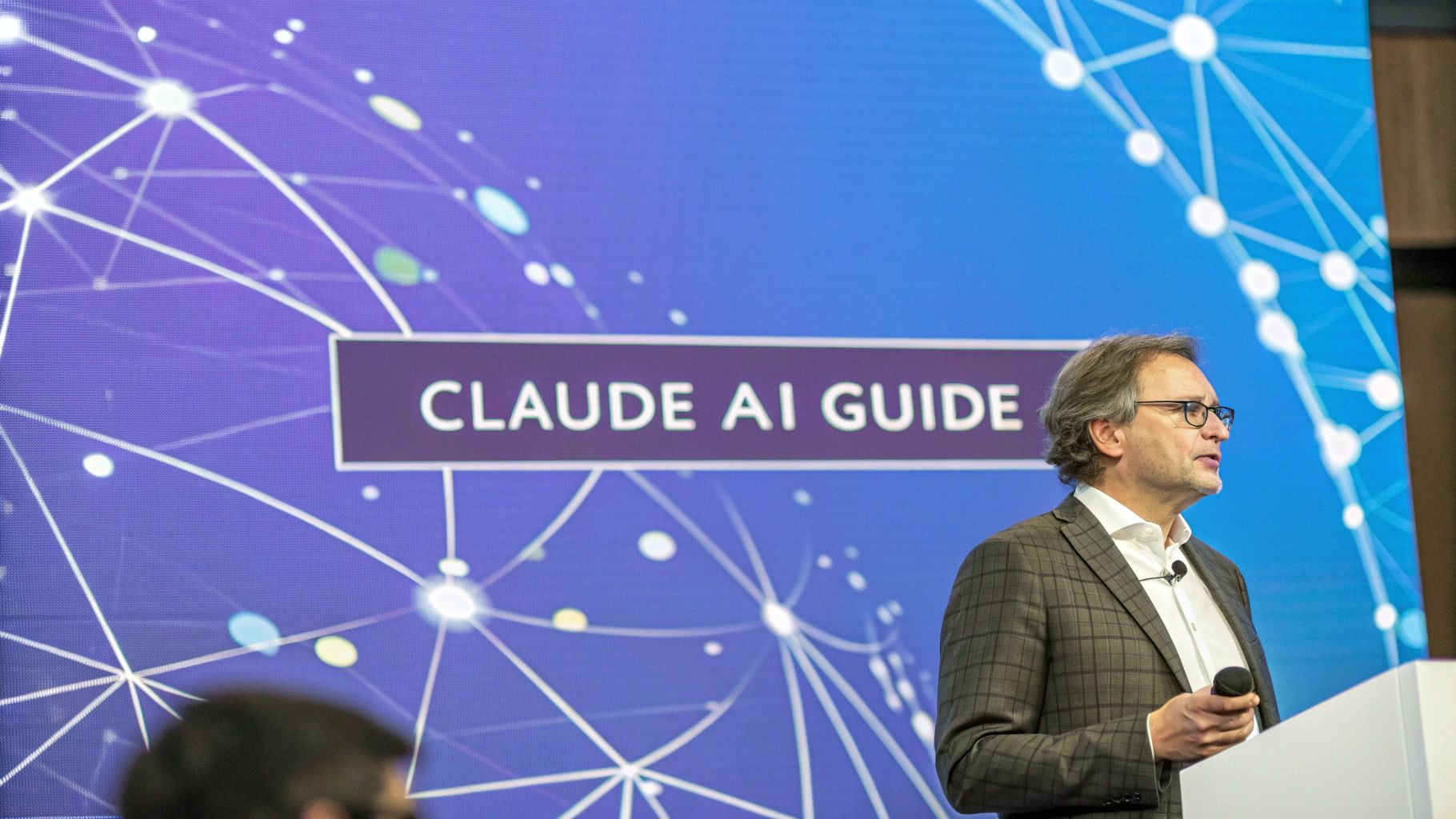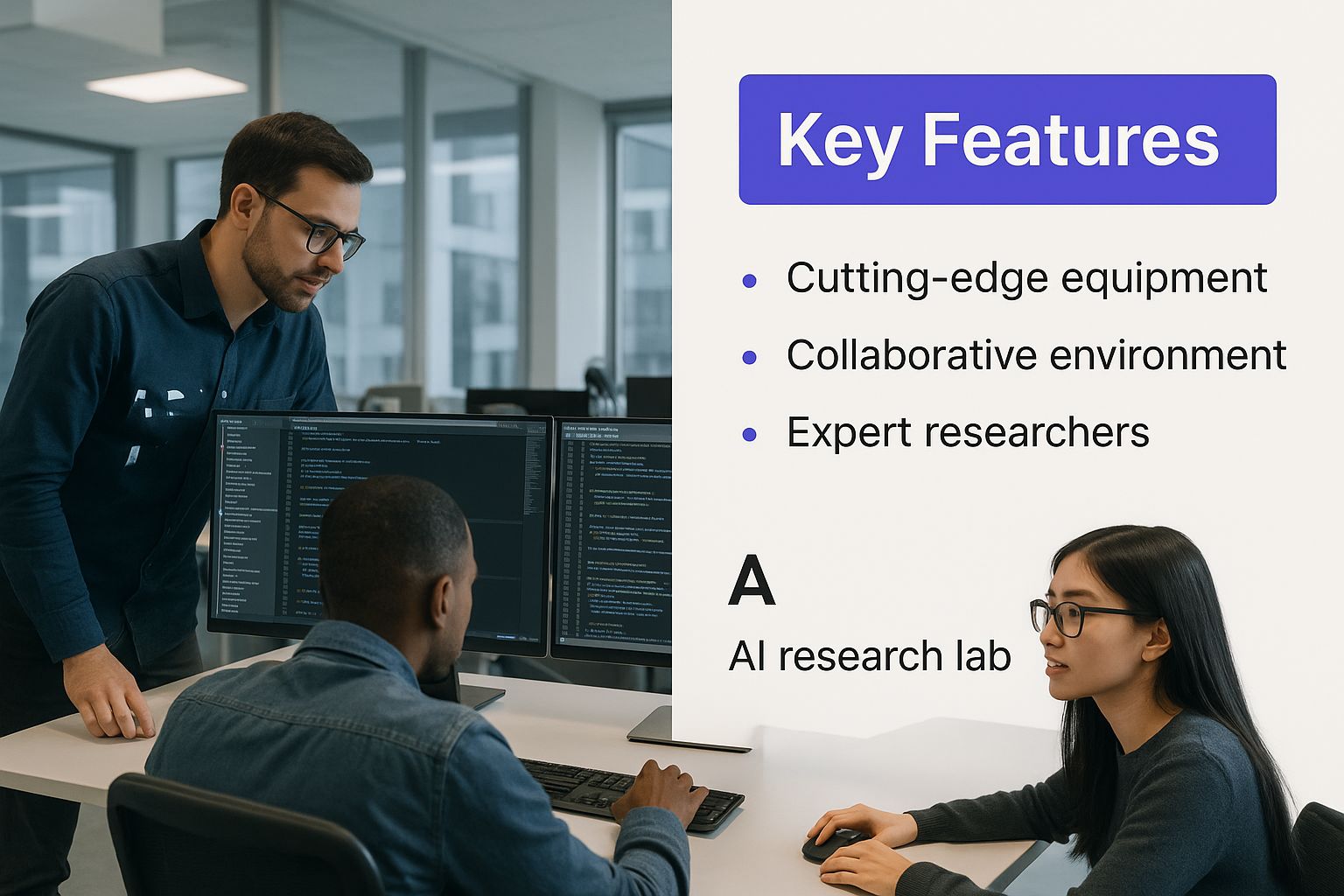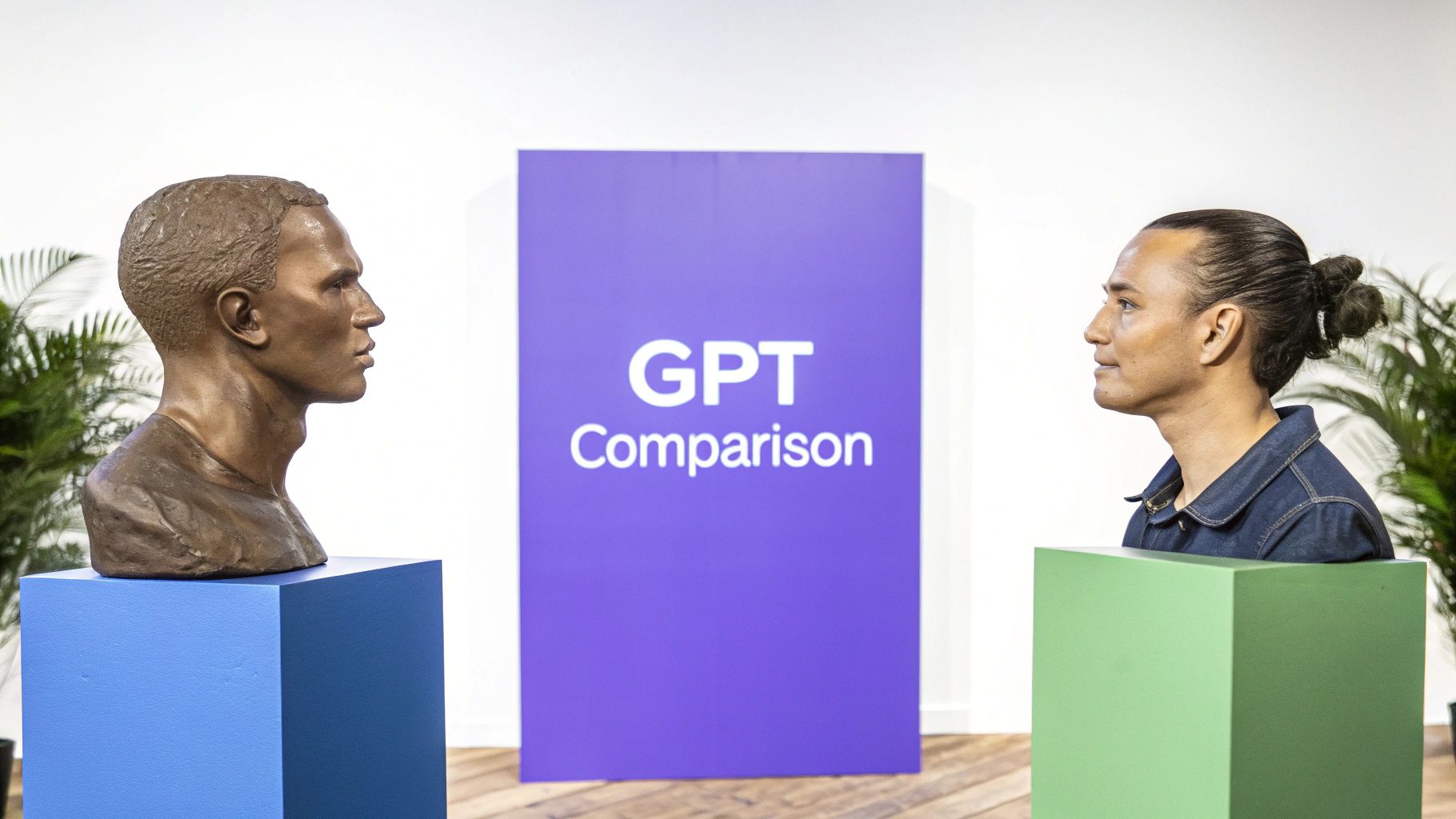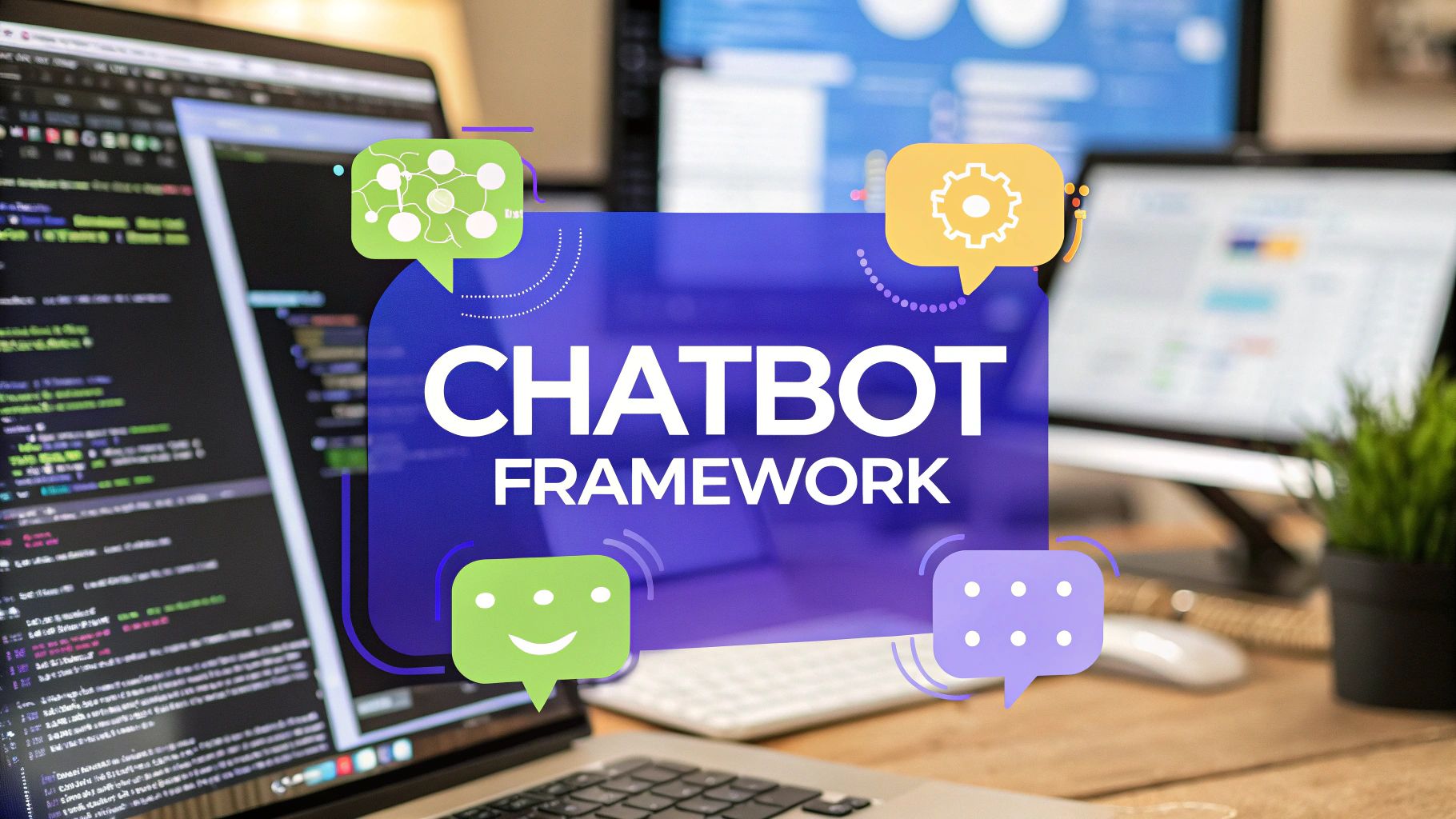A Guide to Claude AI and How It Works
Explore what sets Claude AI apart. This guide covers its unique features, real-world uses, and how Constitutional AI makes it a safer, smarter choice.

You've probably heard of Claude AI. It's the powerful conversational AI from Anthropic, a company that’s all-in on AI safety.
But in a world suddenly crowded with AI tools, what makes Claude different? It’s more than just another chatbot. Claude is built on a unique foundation designed from the ground up to be helpful, harmless, and honest—a philosophy that makes it a trusted partner for everyone from solo creators to massive corporations.
This focus on ethical behavior isn't just a marketing slogan; it's the core reason for its impressive growth.
Since launching in March 2023, Claude's user base has exploded. As of early 2025, it pulled in an estimated 18.9 million monthly active users around the globe. This rapid adoption, which translates to a massive $850 million in annualized revenue for Anthropic, shows just how much people value a reliable AI. You can dig into more of the user growth stats over at Backlinko.com.
The Big Idea: Constitutional AI
So, what’s the secret sauce? At the heart of Claude is a concept called Constitutional AI.
Think of it this way: most AI models learn by absorbing staggering amounts of data from the internet. Claude does that too, but it’s also guided by a "constitution"—a set of principles and rules drawn from sources like the Universal Declaration of Human Rights. This internal rulebook acts as a moral compass.
This built-in ethical framework is designed to steer the AI away from generating harmful, biased, or malicious content. It's an approach that prioritizes safety from the ground up, rather than trying to filter out bad outputs after the fact.
This method ensures every interaction aims to be helpful and safe, making Claude a dependable partner for sensitive tasks. It’s this commitment that attracts users looking for a responsible AI solution.
Claude AI At a Glance
To give you a clearer picture, here is a quick summary of Claude AI's key attributes. This table provides a fast overview of its models and primary goals, showing how it serves different needs while sticking to its core principles.
This at-a-glance view gives you a solid starting point for understanding where Claude fits in the AI landscape. It's a tool built not just for power, but for purpose.
How Constitutional AI Shapes a Safer System
What really makes Claude AI different isn't just its conversational skills—it's the philosophy baked right into its core. The secret sauce is a training method called Constitutional AI. This approach changes the game by teaching the model how to behave ethically from the very beginning, rather than just what to say.
Think about teaching someone to drive. You could show them thousands of hours of driving footage, and they’d eventually figure out the mechanics. A much better way? Teach them the rules of the road first. That's exactly how Constitutional AI works.
Instead of only learning from a mountain of data, Claude is first given a "constitution." This is a set of core principles, drawing from sources like the Universal Declaration of Human Rights, designed to steer its behavior. It’s built to be helpful while actively sidestepping harmful, biased, or sketchy responses.
The Two-Phase Training Process
Putting this constitution into practice happens in two key stages that continuously refine the model’s judgment.
Supervised Learning Phase: First, an initial model learns to generate responses. But then, it’s prompted to critique and rewrite its own answers based on the principles in its constitution. This self-correction loop teaches it to spot and avoid bad content without a human needing to label every single harmful example.
Reinforcement Learning Phase: Next, the model generates a pair of responses for different prompts. It then holds these two responses up against its constitution and picks the one that aligns better with its core principles. This constant self-evaluation makes it progressively better at producing safe and genuinely helpful text.
This whole process is like giving the AI an internal quality control system. It isn’t just churning out content; it’s constantly double-checking its work against a clear set of ethical rules. The goal is an output that's both useful and responsible.
This meticulous, principle-first training is a huge reason why so many businesses trust Claude AI with sensitive and professional work. It builds in a layer of reliability that models trained purely on data can often struggle to match.
Building Powerful Features on a Safe Foundation
This safety-first design doesn't hold Claude back; it actually makes it more powerful. The Claude 3 model family—Opus, Sonnet, and Haiku—shows how a stable foundation can support a diverse range of features. Because the core system is inherently more predictable and aligned, developers can build more ambitious tools on top of it with greater confidence.
A perfect example is Claude's massive context window, which lets it process and reason over incredibly long documents. Imagine analyzing a 150-page legal contract or a dense quarterly financial report in one go. This feature is far more reliable because the constitutional framework keeps the AI's analysis focused, reducing the risk of it generating irrelevant or nonsensical information from such a huge amount of text.
The infographic below breaks down the key features that are all built on this unique AI architecture.

As you can see, the thoughtful design of Claude's core system is what enables its most advanced functions. It’s this smart blend of safety and performance that makes Claude such a compelling choice.
Key Features That Define the Claude Experience

While the theory behind Constitutional AI is impressive, what really matters are the practical, day-to-day features you can actually use. That safe foundation is what allows Claude AI to offer powerful tools that feel both reliable and intuitive. These capabilities go way beyond simple Q&A, unlocking sophisticated workflows that used to be impractical for AI.
This is where we get into the standout features that make the Claude experience so different. From its incredible ability to handle huge amounts of text to its nuanced conversational skills, every feature is a direct result of its thoughtful design. Let's dig into what makes Claude such a capable partner for complex work.
The Game-Changing Context Window
Perhaps the most celebrated feature of Claude AI is its massive context window. Think of a context window as the AI's short-term memory. It defines how much information—text, data, or code—the model can hold and actively consider in a single conversation.
Most models have a pretty limited memory, which forces you to break down large documents or complex problems into smaller, bite-sized pieces. Claude, on the other hand, can process hundreds of thousands of words at once. This isn't just about a bigger number; it fundamentally changes how you can use the AI.
Instead of feeding an AI a few pages at a time, you can upload an entire book, a dense quarterly earnings report, or a full scientific research anthology. Claude can then analyze, summarize, and answer detailed questions about the complete document in one go.
This capacity for deep, uninterrupted analysis makes it an invaluable tool for any professional drowning in information.
Sophisticated Reasoning and Analysis
A large context window is only useful if the AI can actually think logically about the information it’s holding. This is another area where Claude really shines. Its ability to perform sophisticated reasoning allows it to connect disparate ideas, spot subtle patterns, and generate high-level insights from complex data.
For example, a financial analyst could upload multiple market reports and ask Claude to synthesize the key trends and point out any contradictions. Or a legal team could feed it a lengthy contract and ask for a plain-English summary of all clauses related to liability. These are tasks that require genuine comprehension, not just simple information retrieval.
Here are a few real-world examples of its reasoning power in action:
- Legal Document Review: Identifying risks, obligations, and key dates across hundreds of pages of dense legal text.
- Scientific Research: Summarizing multiple academic papers to produce a literature review or pinpoint gaps in current knowledge.
- Business Intelligence: Analyzing customer feedback, support tickets, and sales data to find strategic opportunities.
This analytical depth, combined with its huge context window, makes Claude a powerful assistant for any kind of knowledge work.
Tailored Speed and Performance
Anthropic gets that not every task needs the same level of horsepower. That’s why the Claude 3 family offers a range of models, each one tuned for a different balance of performance, intelligence, and cost. It’s all about giving you the right tool for the job.
The three main models offer distinct advantages:
This tiered approach makes powerful AI much more accessible. A small business can use Haiku for affordable, real-time customer support, while a large enterprise can deploy Opus for deep strategic analysis. It ensures that the robust capabilities of Claude AI aren’t limited to only the most resource-intensive applications. This flexibility, rooted in a safe and reliable core, is what truly defines the modern Claude experience.
Putting Claude AI to Work in the Real World
Theory and safety protocols are one thing, but how does this technology actually perform when the rubber meets the road? You start to see the real value of Claude AI when you look at how it’s being applied across different industries to solve tangible problems.
From busy customer support centers to high-stakes financial trading floors, Claude is becoming a go-to partner for professionals who need much more than a simple chatbot. It's a powerful tool for reasoning, analysis, and creation.
Let’s dig into a few specific examples of how it’s making a difference.
Transforming Customer Support and Operations
One of the most immediate places you'll see Claude AI making an impact is in customer service. Teams are using its advanced conversational skills and massive context window to tackle complex issues with far more speed and accuracy.
Imagine a support agent helping a customer with a long, messy history of technical problems. Instead of digging through old tickets and chat logs, the agent can feed the entire history into Claude and get an instant summary. This gives them the full context in seconds, letting them offer a solution that actually works—a win for both efficiency and customer satisfaction.
This isn't just about answering basic FAQs. Claude can analyze the sentiment in customer feedback, spot recurring problems across thousands of support tickets, and even help draft empathetic, technically sound responses for agents to use.
This kind of operational intelligence helps businesses streamline their support functions, freeing up human agents to focus on the truly tough customer challenges. For a deeper look at how AI assistants are changing this space, check out our guide on AI chatbots.
Fueling Financial Analysis and Research
The world of finance runs on information, and that information is often buried in dense, hundred-page reports. A financial analyst might need to pull key insights from market data, earnings call transcripts, and regulatory filings—a process that can easily eat up hours, if not days.
With Claude, that workflow gets a serious speed boost. An analyst can upload an entire quarterly earnings report and ask sharp questions like, "What were the main drivers of revenue growth this quarter, and what are the biggest risks mentioned in the forward-looking statements?" Claude can pull out and synthesize this information in minutes.
This capability has been a major reason for its growing footprint in the market. By 2025, Claude AI commands an impressive 21% of the global large language model usage market, second only to ChatGPT. Its adoption in enterprise AI assistant applications has surged to 29%, and it has even surpassed competitors in the customer service AI tool segment, now managing 28% of support tickets worldwide through its various integrations.
Unlocking Creativity and Technical Efficiency
Beyond corporate boardrooms, Claude is also proving to be a powerful sidekick for creators and developers.
Creative Writing: Authors and screenwriters use Claude to brainstorm plot points, flesh out character backstories, or just break through a stubborn case of writer's block. By feeding it a chapter or script, they can get instant feedback on pacing, dialogue, and tone.
Software Development: Programmers can drop an entire codebase into Claude for help with debugging, code optimization, or even translating code from one language to another. It can explain complex functions and help onboard new developers to an existing project much faster.
Academic and Legal Work: Researchers are using it to generate literature reviews from dozens of academic papers, while legal professionals rely on it to analyze contracts and case law, identifying key clauses and potential risks with incredible speed.
In every one of these scenarios, Claude AI acts as a skilled assistant that enhances human expertise, not replaces it. By handling the heavy lifting of processing information, it frees up professionals to focus on what they do best: high-level strategy, creativity, and decision-making.
Who Is Using Claude AI and Why
It’s one thing to talk about Claude's technical specs, but the real story is told by the people and businesses who use it every day. When you look at who’s choosing Claude and what they’re using it for, a clear picture emerges, showing exactly where it shines in the crowded AI landscape.
There’s a definite magnetic pull for a younger, more technically-minded audience. This group is often the first to jump on new technologies, and they find Claude’s power to handle complex information incredibly useful. Its ability to reason through dense material makes it a natural fit for the demanding work common in tech and academia.
The Technical and Professional User Base
A quick look at the user stats shows just how popular Claude is with young professionals. The largest group of users falls in the 18-24 age range, making up 8.3 million users. The next biggest segment is the 25-34 age bracket, which adds another 4 million active users.
This trend makes perfect sense when you see what they're using it for. Over 37% of all queries are related to computer or mathematical fields. You can dig deeper into these trends and statistics over at AboutChromebooks.com.
This preference among technical pros isn't a coincidence; it's a direct result of Claude's design.
People in fields like software development, data science, and academic research need more than just a chatbot. They need a tool that can analyze a codebase, make sense of statistical data, or summarize a dense research paper with high accuracy. These are all areas where Claude stands out.
Its massive context window and sophisticated reasoning abilities make it feel less like a simple chatbot and more like a powerful assistant for anyone doing deep knowledge work. This is what separates it from more general-purpose AIs and establishes it as a serious professional tool.
To illustrate just how significant this demographic is, here’s a breakdown of Claude AI’s global user base.
Claude AI User Demographics by Age
A breakdown of Claude AI's global user base by age group, illustrating its primary audience and adoption rates across different generations.
As the numbers show, adoption is heavily concentrated among users under 35, who represent the core of its technical and professional audience.
Widespread Adoption in the Enterprise World
It’s not just individual developers and researchers who have taken notice. Claude AI has made significant inroads in the corporate world, where things like reliability and safety are non-negotiable. Today, an estimated 60% of Fortune 500 companies use Claude in some form. That level of adoption is a huge vote of confidence from major corporations who trust its performance and ethical guardrails.
This trust is built on Claude’s reputation for delivering consistent and harmless responses, which is a direct outcome of its Constitutional AI framework. For a large enterprise, this isn't just a nice-to-have feature—it’s a core requirement. The risk of an AI spitting out biased, inaccurate, or inappropriate content is a massive liability, making Claude’s built-in safety a key reason for its appeal.
Companies are weaving it into all sorts of workflows, including:
- Customer Service Operations: Automating responses and giving support agents instant access to customer histories and technical documentation.
- Legal and Compliance: Scanning contracts and regulatory documents to flag risks and ensure compliance.
- Strategic Analysis: Synthesizing market research reports and internal data to help leaders make better-informed decisions.
By offering a dependable and powerful platform, Claude helps teams tackle complex jobs with more confidence. This is especially true in customer-facing roles, where an AI chatbot for customer service has to be both helpful and completely safe. Its ability to check both of these boxes explains why it’s growing so quickly in professional settings.
Claude AI Versus Other Leading Models

Choosing the right AI model isn't about finding a single "winner." It's more like picking the right tool for a specific job. While giants like OpenAI's ChatGPT and Google's Gemini are known for their incredible versatility, Claude AI has carved out its own space by doubling down on a few key strengths.
The real difference comes down to their design philosophies. ChatGPT is often praised for its creative spark and broad conversational skills, making it a go-to for brainstorming and content creation. Gemini shines with its deep integration into the Google ecosystem and its knack for handling multimodal tasks.
Claude, on the other hand, was built with a different goal in mind. Its foundation in Constitutional AI gives it a serious advantage in professional settings where safety, precision, and reliability are non-negotiable. This built-in ethical framework leads to more predictable and trustworthy outputs, which is a huge reason why so many businesses are bringing it on board.
Comparing Core Strengths
The models really show their true colors when you put them to work on specific tasks. One might be perfect for a quick, creative idea, while another is built for deep, analytical heavy lifting. The right choice depends entirely on what you're trying to get done.
This is where Claude AI's massive context window becomes a true game-changer. It’s not just about having a bigger memory; it's about the ability to reason over huge amounts of information in a single, coherent pass.
This capacity for deep-dive analysis makes it the perfect solution for industries drowning in dense documentation. Legal teams can feed it entire contracts for analysis, and financial analysts can synthesize multiple market reports at once, all without having to chop up the data. While other models are catching up, Claude still leads the pack in processing and making sense of exceptionally long documents. It's a key ingredient in many business process automation examples where large data sets are the norm.
Performance and Practical Applications
When it comes to day-to-day performance, each model has its own distinct personality. ChatGPT is a powerful generalist, great at creative writing and surprisingly good at coding tasks. Its knack for generating new ideas has made it a favorite among marketers and writers.
Claude’s strength, in contrast, lies in its incredible comprehension and summarization skills. It excels at taking tangled, complex information and distilling it into clear, accurate insights. For jobs like creating a detailed literature review from dozens of academic papers or summarizing dense technical manuals, Claude’s performance is second to none. This makes it an invaluable tool for researchers, analysts, and anyone whose work involves deep knowledge.
Ultimately, the best choice comes down to what you need it for. If your priority is creative exploration and all-around assistance, ChatGPT or Gemini might be your best bet. But if your work demands unwavering safety, deep analysis of large documents, and reliable reasoning, Claude AI offers a focused and powerful solution that's hard to beat.
Got questions about Claude? You're not alone.
Even after you've dug into the features and seen how it stacks up against other models, some practical questions always come up. Here are a few of the most common ones we get, with straightforward answers to help you get a complete picture of how Claude works day-to-day.
How Does Claude Handle My Data?
This is a big one, and Anthropic is pretty clear about its approach. If you're using the free, public-facing version of Claude AI, your conversations are not used to train their models unless you explicitly opt in.
For businesses using the API, the policy is even stricter: your data is never used for training. Period.
This hard line on data privacy is a huge reason why so many companies feel comfortable using Claude for work involving sensitive or proprietary information.
Your data privacy is foundational to how Claude operates. Anthropic has built technical barriers and strict policies to prevent your private inputs from being absorbed into their core training datasets, respecting user confidentiality by design.
Can I Train Claude on My Own Content?
Yes, but maybe not in the way you’re thinking. You can't permanently fine-tune the core Claude models like you might with some other platforms.
Instead, Claude lets you provide your own documents and data within a single conversation. Thanks to its massive context window, you can upload huge files—think entire company knowledge bases, detailed style guides, or complex project briefs.
Claude then uses that information as its "single source of truth" for that specific chat, essentially becoming a temporary expert on your content. It’s a powerful way to get customized answers without altering the underlying model itself.
Is Claude AI Free to Use?
Yep, there’s a free version of Claude AI available right on their website, and it’s a fantastic way to get started. It usually runs on a capable model like Sonnet and gives you plenty of runway for most everyday tasks.
For more demanding work, there are paid plans:
- Claude Pro: This gets you access to Opus, their most powerful model, along with higher usage limits and priority access when things get busy.
- Claude API: Aimed at developers, this option lets you build Claude's models into your own apps. Pricing is based on how much you use it (specifically, how many tokens you process).
The free version is surprisingly powerful, but if you’re a professional who needs top-tier reasoning or you’re running a high volume of queries, the Pro plan is a solid investment.
Why Is It Named Claude?
The name "Claude" was chosen to feel friendly and approachable, reflecting the AI's design philosophy of being a helpful, trustworthy assistant.
It was reportedly inspired by Claude Shannon, a brilliant American mathematician and engineer who is often called the "father of information theory." His pioneering work laid the mathematical foundation for much of modern computing and digital communication.
Ready to build an AI assistant trained on your own business data? With Chatiant, you can easily create custom AI agents and chatbots that integrate directly with your website and internal tools like Google Chat or Slack. Automate customer support, streamline operations, and empower your team. Start building your custom AI agent with Chatiant today!


